A Killer Project
January 31, 2011 at 10:35 pm · Filed under Content / Architecture, Copy / Writing, Drawing / Illustration, Information / Mapping, Print / Editorial
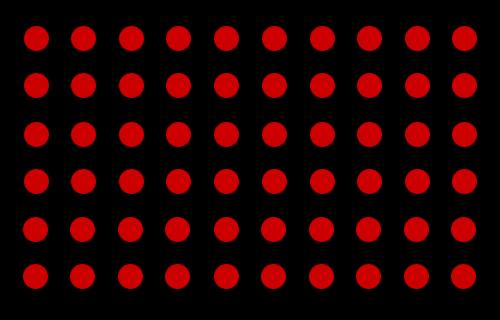
lives being lost to Cardiovascular Disease (shown in real time; multiply by 25,000 for annual number) animated illustration for presentation; source: 2000 U.S. Census; originally 10 x 7ft. (projected) / 2004
Data is boring. It’s just facts and figures; numbers on a page. There’s no life in it: No blood, sweat or tears, not to mention sex. But actually, there almost always is. Nearly all data is merely classified results of the choices people make. If someone didn’t make enough money to pay their phone bill. If someone trained hard enough to win an Olympic bronze medal. If someone was found 30 stories below a penthouse balcony. There is data that can tell us all about these things. Unfortunately, it’s too often left flat, or worse, twisted up in knots, suffocated and sputtering in it’s own purple ink. It is in the mindful extrication, marrying and expression of data that its ones and zeroes may come to life, breathe in our faces and tell us to pay attention for a minute because it’s going to help us understand the beautiful and the terrifying things we’ve done. This is information design.
Nothing should teach us more about ourselves than adversity, and that’s what we were faced with in Information Design, one of the most sweat-worthy courses in the decidedly rigorous Visual Communication Design program at the University of Washington. Indeed, the subjects of our designs were nothing short of catastrophic: groups were assigned strains of natural disasters or epidemics to seek out, research and present based on their potential merit to inform through design. After this, we were to design at least three magazine spreads of narrated information graphics individually.
Our research team, comprised of Jesse Graupmann, Jim Nesbitt and myself came upon Cardiovascular Disease (CVD), by far the United States’ most prolific killer. In terms of deaths and monetary expenditures, raw data makes it clear that CVD, which encompasses Heart Attack, Stroke, and various other arterial conditions, is a significantly larger problem than any other known phenomenon.

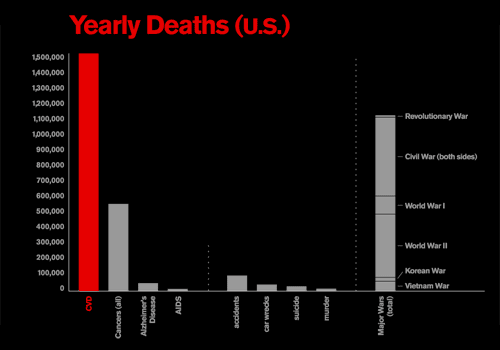
comparison of annual deaths between Cardiovascular Disease, and other notable causes of death, as well as the total deaths accrued in all significant U.S. wars; (roll over to enlarge) [sources: American Heart Association, 2003; Centers for Disease Control 2003; U.S. Pentagon, 2000]; originally 10 x 7ft. (projected) / 2004
Currently, on average, CVD kills about 1.5 million people per year in the U.S. or one every 33 seconds, accounting for 39.4% or one of every 2.5 deaths in the year 2000. Even all forms of cancer combined don’t kill as many people as does Coronary Heart Disease alone, just one of several types of Cardiovascular Disease. This is not to mention non-disease related deaths such as murders or accidents, which also pale in comparison to CVD. Perhaps most shocking is that more people die of Cardiovascular Disease each year than were killed in every major U.S. war, combined.

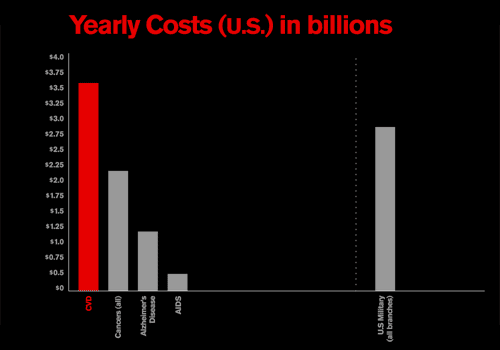
comparison of annual costs between Cardiovascular Disease, Cancer, Alzheimer’s Disease and AIDS, as well the combined annual budget for the U.S. military (roll over to enlarge) [sources: American Heart Association, 2003; Centers for Disease Control 2003; U.S. Pentagon, 2000]; originally 10 x 7ft. (projected) / 2004
In our presentation to the class, we introduced these and other such daunting facts with the animated chart at the top of this post projected behind us, illustrating deaths occurring due to the disease even as we were making the presentation. We made a pretty good case, and we were off on our own to dive in and make those facts dance their deadly dance in the pages of our own magazine articles.
But having the undisputed king of killers wasn’t enough for me. I was thirsty for more blood. I suppose I wanted more sex in it, too. Based the numbers above, Cardiovascular Disease sounds pretty bad, but how could it be worse than HIV and AIDS? I set out to answer this question by comparing the two based on five critical factors…
Both Cardiovascular Disease (coded in yellow, in relation to the arterial plaque that makes the condition) and HIV/AIDS (coded in green, in relation to the general notion of debilitating illness that sooner or later plagues its carriers) are national epidemics. But, in terms of probability of affliction, deaths and monetary expenditures, raw data makes it clear that Cardiovascular Disease, which encompasses Heart Attack, Stroke, and various other arterial conditions, is a significantly larger problem than HIV/AIDS. However, the latter receives far more media draw, and, though spending on CVD exceeds HIV and AIDS by quite a wide margin, spending in proportion to death rate is actually much lower.
Roll over any of the spreads below to see them much larger

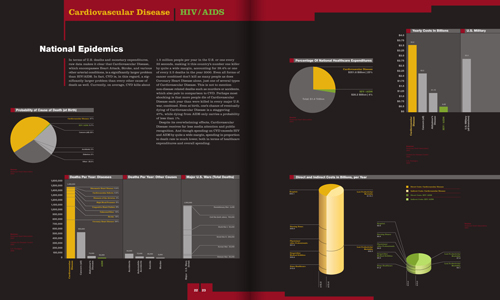
National Epidemics magazine article segment comparing monetary and mortality statistics of Cardiovascular Disease vs. HIV/AIDS; 20 x 12in. (spread) / 2004
Looking closer at those affected by Cardiovascular Disease or HIV and AIDS reveals a more compelling statement regarding public perception. It is without question that Cardiovascular Disease affects and kills far more people overall than does HIV and AIDS; this transcends racial, gender, and geographic borders. However, HIV is actually slightly more prevalent in young adults aged 25 – 34. While the death rate of AIDS is still less in this group than that of CVD, being infected by a life-threatening, terminal disease in the prime of one’s life is obviously a crushing blow and likely plays a key role in the cultural awareness and fear of AIDS not present in regard to Cardiovascular Disease.
Geographically, prevalence of Cardiovascular Disease is strongly correlated to broad regions of the U.S., while HIV and AIDS cases tend to be concentrated in major metropolitan areas. Generally speaking, CVD affects those in the South significantly more than other regions. Several Southern states have even been grouped and labeled as the “Stroke Belt.” Speculation as to the cause of this geographic bias points to the prevalence of two major risk factors: poor diet and inactivity. Specifically, the common practice of deep-frying many foods contributes significantly to elevated cholesterol levels. High temperatures in this region are also thought to contribute to the population’s high rate of inactivity.

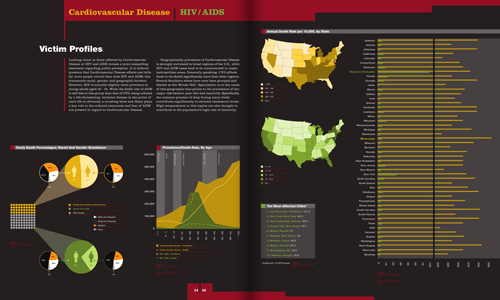
Victim Profiles magazine article segment comparing demographics of those affected by Cardiovascular Disease vs. HIV/AIDS; 20 x 12in. (spread) / 2004
Though HIV and AIDS are much younger conditions than Cardiovascular Disease (indeed, Stroke was first recognized by Hypocrites over 2,400 years ago), both have seen a steady rise in prevalence in recent times. This progression has not occurred randomly. Various risk factors and behaviors contribute to the probability of being afflicted by either illness.
In the case of Cardiovascular Disease, there are a few risk factors, such as hereditary predisposition, for which there is little recourse. However, the bulk of risk factors stem from modifiable lifestyle choices. Chief among these are adequate exercise and proper diet. Americans have become steadily less active over the last fifty years, which has led to massive obesity. Without regular moderate exercise, the heart grows weaker and obesity forces it to work harder than it is prepared. Though some diet choices have improved over the years, others have worsened, canceling out most positive changes.
HIV, too, has risky behavior as its primary champion. Unsafe sexual contact with infected persons and sharing “dirty” needles are the two most prominent and most avoidable modes of transmission. Safer sex practices, such as condom usage, have increased slightly and needle-exchange programs have worked hard to curb infected needle usage, but overall behavior patterns have not changed significantly since initial public recognition of the disease.

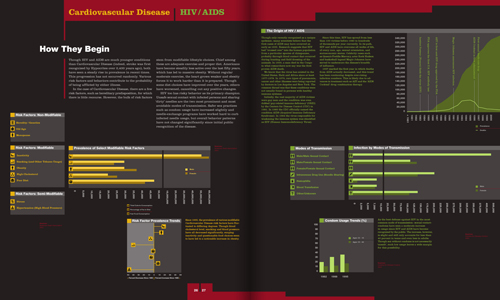
How They Begin magazine article segment comparing risk factors of Cardiovascular Disease vs. HIV/AIDS; 20 x 12in. (spread) / 2004
The physiological processes by which Cardiovascular Disease (CVD) and HIV/AIDS progress are significantly different. CVD is actually a very simple, localized mechanical process whose effect can be easily seen by the naked eye (once revealed in surgery), while HIV/AIDS is much more complicated and widespread, and operates entirely on a microscopic level.

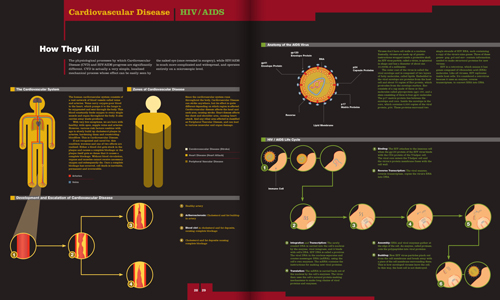
How They Kill magazine article segment comparing how Cardiovascular Disease and HIV/AIDS affect the body; 20 x 12in. (spread) / 2004
Once affected by either Cardiovascular Disease or HIV/AIDS, appropriate management is crucial. In this realm, Cardiovascular Disease patients have a number of options at their disposal. If a severe cardiovascular event such as a Heart Attack or Stroke occurs, surgical action is necessary and must be performed immediately for any chance of survival or recovery. However, warning signs such as throbbing pain in the area affected often precede these events by minutes, hours or even years. If caught early enough, Cardiovascular Disease is quite treatable and its progression can actually be reversed. This can be accomplished by way of lifestyle changes, various cholesterol or blood pressure-lowering medication or, if particularly severe, surgery.
Unfortunately, the same cannot be said for those with HIV/AIDS. Tragically, there is still no cure for HIV or AIDS, but, after close to twenty-five years of intense research and development, pharmaceuticals have come a long way toward managing the conditions. AZT was the first anti-HIV drug approved by the FDA in 1986 and is still used today. The now famous “AIDS Cocktail” (which often includes AZT) is the currently the treatment of choice, but this regimen is neither cheap nor simple. A handful of harsh drugs must be taken on a precise schedule several times a day, every day, for the rest of one’s life. The course demands very specific diet and eating habits to work properly. It is so important that this schedule not be deviated from that many patients are advised to ‘practice’ with different kinds of candy for weeks before actually beginning cocktail treatment. Once committed to the regime, the drugs can make the patient very nauseated and may even be rejected outright by the body. If this occurs, then various alternative drugs must be experimented in hopes that a suitable treatment can be reached.

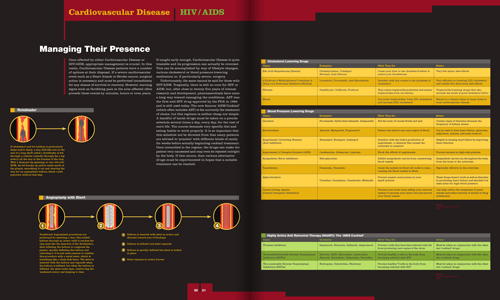
Managing Their Presence magazine article segment comparing treatment options for Cardiovascular Disease vs. HIV/AIDS; 20 x 12in. (spread) / 2004
Since this was just an academic exercise never published in the public realm or even read by anyone other than possibly classmates—who were facing their own disasters—and a few competition judges I don’t know, I can’t say how this translation of data might be able to affect others. But, speaking for myself, I can tell you that processing this information, expressing it graphically and digesting it once came together was deeply affecting. Indeed, this was probably the most depressing project I’ve ever designed. I don’t think I actually shed tears, but it certainly made me sad.
